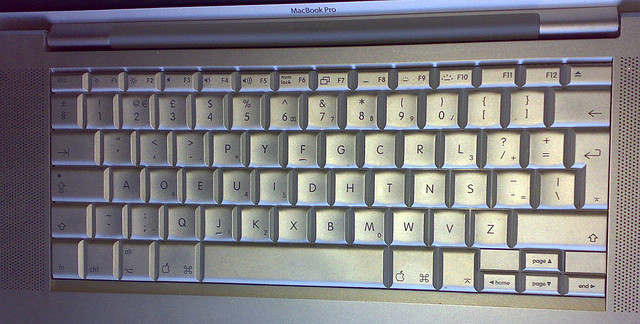Look down at the keyboard in front of you. If you set your fingers on the keys, your index fingers rest on the J and F keys, correct? Upper left hand letter is a Q? Then you are using what is known as a QWERTY keyboard, the most common keyboard format on the market today. It was originally created in 1873 by Christopher Latham Sholes, the inventor of the typewriter, because putting the letters in alphabetical order caused the arms in the typewriters to tangle and jam.

Did you know that there are other options?
The Dvorak keyboard layout was created in 1932 by Dr. August Dvorak. It rearranges the keys on the keyboard so that, for example, the home keys for your left hand are AEOU instead of ASDF.
There are many pros and cons to switching from the standard QWERTY keyboard layout to the not as common Dvorak layout.
Pros
- No special software needed. Almost all Windows and Mac computers already have the capability to remap the keyboard for Dvorak.
- Speed. Many speed typists use the Dvorak format, and have been known to reach typing speeds of over 150 wpm, even peaking at over 200 wpm in some cases. Don’t know your wpm? Check it at http://www.ratatype.com/typing-test/.
- Comfort. People who complain of pain while typing on a standard format keyboard often find that their pain is relieved or eliminated by switching to a Dvorak keyboard. It is an ideal format for people suffering from repetitive stress injuries. (It should be noted that this is not a cure-all and you should not neglect visits to your primary care physician should RSIs become an issue).
- Time spent learning. Studies have shown that the time it takes to learn to type with the Dvorak format is about 1/4 of the time it takes to learn a QWERTY keyboard. This will, of course, vary from person to person. It is also easier to learn Dvorak for new typists than it is to retrain someone who already knows the QWERTY system well.
- Ease of Use. The key arrangement of the Dvorak keyboard is much more logical than the arrangement of its standard counterpart. The QWERTY keyboard was designed strictly to put letters that are used commonly together, as far apart on the keyboard as possible. In the designs of the original typewriter, this kept the letter arms from jamming. In keyboard designs, though, this may not be the most practical.
- Accuracy. Because the keys are arranged for efficiency, it’s easier to maintain a high accuracy rating when typing.
Cons
- Learning Curve. While it is quicker to learn the Dvorak format keyboard, you are not going to maintain the same typing speed if you are constantly switching back and forth between the QWERTY and Dvorak formats.
- Cost. While this is not always an issue, buying a Dvorak keyboard can get expensive. There isn’t a high demand for them so the prices tend to be higher. A way around this could be to simply pop your keys off and rearrange them in the Dvorak format.
- It’s an all or nothing kind of thing. You can’t learn the Dvorak keyboard format a little at a time while still typing away at work or at home on your QWERTY keyboard. They are not skills that can be used simultaneously.
- Computers default to QWERTY. Even if you have remapped your computer and keyboard for the Dvorak format, the default setting when you boot up, and for password screens, will be QWERTY.
- Short cut keys have relocated. For anyone who relies on Ctrl-C and Ctrl -V for a quick copy and paste, the Dvorak format may not be the best idea. The format moves the C and V keys where they are not as easily accessible for short cuts.
- Not Bilingual. The Dvorak format was designed for use with the English language and even to this day, it works the best with English. While it is usable for other languages, it’s not nearly as effective.
- The world runs on QWERTY. Go to a library, or an employment kiosk, and every keyboard you encounter is going to be set up in the QWERTY format. If you run exclusively Dvorak on your home and/or work computer, this could cause issues and reduce you to hunt and peck typing speeds.
QWERTY and Dvorak both have their benefits and disadvantages. If you have some free time on your hands, and don’t have to type for a living, think about giving the Dvorak format a try. Who knows? It may spark your new carrier as a record holding speed typist.
Adam Fort is an education enthusiast and advisor at Ratatype typing tutor.
